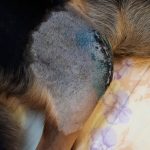Hello,
It is always best to contact your vet and/or surgeon to discuss any and all post op questions. I can add that in general I don’t worry if my patents are lying on their incisions. If they are comfortable enough to do that I actually feel better about them post op. But please call your vet. Infection is always a worry and assessing it ASAP is very important.
My dog has a drain in his ear for an aural hematoma. It has been in for a week and is supposed to be in for 2 more but it appears as though it may be coming out. What happens if it comes out before we get to the vet?
Comments
My dog had a patella surgery 8 days ago. I read somewhere its ok to let him lie down on the side where his incision is, so I let him. But today I noticed a fluid buildup around his incision site. Its not warm to the touch and the incision isnt reddish. The orthopedic surgeon that did the surgery is far away, we have an appointment with him in a week for my dog’s suture removal.
Has anyone had experience similar to this? I read its a seroma and its better to leave the body absorb it naturally. I called my local vet and she recommended needle aspiration, Im not sure its the best idea. Advices, please.. IM AFRAID HIS SUTURES WILL BURST.
P.S. my dog develops bumps every time he gets vaccinated or when he’s given a shot subcutaneously
Comments
My dog got his duclaw caught on a piece of string and is whining a lot. Is there anything we can give him to help with the pain? He won’t let me near it to see how bad the damage is but if I can give him something, maybe he’ll settle enough to take a look.
Hi. My Cocker Spaniel sleeps with us and has done since she was 6 months old, she is now nine. Lately if my hubby gets up to use the bathroom she begins to growl at him. She loves him to bits, why is this?
Comments
My cat has these black, crusty spots on her chin. What are they and is it ok to put peroxide on them?
Comments
I have a senior cat who was receiving insulin but is now off of it per the Doctor’s orders. His glucose level has returned to normal, at least for now, by way of the DM cat food only.
The cat has become very playful, like a kitten, during the last week or so. Should I be concerned about the change in behavior?
Comments
So, we just adopted a 3 year old Morkie, and were warned that sometimes she’ll steal an article of clothing, hide under a table with it, and possibly bite if you try to get it back from her. Well, I just doctored my girlfriend’s fingers after a little fight they had over a sock. Other than yelling at her (the dog) and saying “no” we’re now ignoring her. What’s the best way to handle this and train her to behave better?
Comments
My 10 year old cat was diagnosed with mammary cancer. Her tumors are too large to go through surgery. I recently, had dog pass from cancer. I chose to treat with prednisone. Can I do the same for my cat?
Comments
My guinea pig probably has something stuck in her throat like a leaf or something. She tries to get it out by rubbing her face or making weird faces. What should I do? She seems calm after an hour but isn’t eating since it got stuck. Will she be able to get rid of it herself!?I tried to look but couldn’t see anything. It straight after she ate a waxy leaf I think. I’m extremely worried. No vet available at the moment
Comments
Hello,
I have a 12 week old kitten who was spayed 11 days ago. I noticed after the 4th day that she had some swelling under her incision. I took her to the ER vet who did an US and said the internal stitches were still intact and there was no hernia. She aspirated some sanguious fluild and looked at it under the microscope and said she was infection free. The kitten had been confined to the bathroom since the spaying but I found out on the third day she was jumping in and out of the bathtub. Hard to keep a 12 week old kitten still and quiet! So after the vet visit we confined even more so- in a free standing shower for 5 days. I then noticed it was firmer- maybe 10% smaller- but definitely firmer looking- more defined. So back to the Er vet who did a second US and said all looked good- no hernia. She then said to let her out of the shower and resume normal activity- the serima should resolve. I was like what! That’s the opposite of what the other vet said. The kitten has been eating and acting normal all through this recovery period. I check the serima daily and it’s the same size. Do I let her tossel with her sibling? How long will it take for the body to reabsorb it? And why did it get firmer after she drained it? I’m so conflicted what to do. Some sites says it takes weeks- I might be impatient. The incision has almost completely healed and looks good. I’m so confused as to how I should be treating this!
Thanks so much!!















Call the vet ASAP and see if they can adjustbit so it doesn’t come out prematurely. I don’t know what kind of drain they used but often I can resecure it in place quickly and easily. Let me know what happens
Hi Dr. Magnifico,
We actually go to JVC and have an appointment Monday (10 days from puttin it in)for the drain to be checked. I will call today but I know you have limited hours. Thanks for responding!
Hello!
Thanks for letting me know. If you are worried Dr. Ahrens is working today. She can help. Weather permitting I am there tomorrow. Who put the drain in for you?
And send a photo I might be able to help via that.
Thanks for using Pawbly. And Jvc.
Dr. Graf put it in last Friday. I called this morning and she actually has an appointment this afternoon so we are going in at 1. We are new to JVC but love it so far! Thanks so much for your help!